Paragliding
Paragliding is a recreational and competitive flying sport. A paraglider is a free-flying, foot-launched aircraft. The pilot sits in a harness suspended below a fabric wing, whose shape is formed by the pressure of air entering vents in the front of the wing.
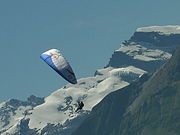
Contents[hide] |
History
In 1954, Walter Neumark predicted (in an article in Flight magazine) a time when a glider pilot would be “able to launch himself by running over the edge of a cliff or down a slope … whether on a rock-climbing holiday in Skye or ski-ing in the Alps”.[1]
In 1961, the French engineer Pierre Lemoigne produced improved parachute designs which led to the Para-Commander (‘PC’), which had cut-outs at the rear and sides that enabled it to be towed into the air and steered – leading to parasailing/parascending.
Sometimes credited with the greatest development in parachutes since Leonardo da Vinci, the American Domina Jalbert invented in 1964 the Parafoil which had sectioned cells in an aerofoil shape; an open leading edge and a closed trailing edge, inflated by passage through the air – the ram-air design.[2]
Meanwhile, David Barish was developing the Sail Wing for recovery of NASA space capsules – “slope soaring was a way of testing out … the Sail Wing”.[3] After tests on Hunter Mountain, New York in September 1965, he went on to promote ‘slope soaring’ as a summer activity for ski resorts (apparently without great success).[4] NASA originated the term ‘paraglider’ in the early 1960’s, and ‘paragliding’ was first used in the early 1970’s to describe foot-launching of gliding parachutes.
Author Walter Neumark wrote Operating Procedures for Ascending Parachutes, and he and a group of enthusiasts with a passion for tow-launching ‘PCs’ and ram-air parachutes eventually broke away from the British Parachute Association to form the British Association of Parascending Clubs (BAPC) in 1973. Authors Patrick Gilligan (Canada) and Betrand Dubuis (Switzerland) wrote the first flight manual "The Paragliding Manual" in 1985, officially coining the word Paragliding.
These threads were pulled together in June 1978 by three friends Jean-Claude Bétemps, André Bohn and Gérard Bosson from Mieussy Haute-Savoie, France. After inspiration from an article on ‘slope soaring’ in the Parachute Manual magazine by parachutist & publisher Dan Poynter,[5] they calculated that on a suitable slope, a ‘square’ ram-air parachute could be inflated by running down the slope; Bétemps launched from Pointe du Pertuiset, Mieussy, and flew 100 m. Bohn followed him and glided down to the football pitch in the valley 1000 metres below.[6] ‘Parapente’ (pente being French for slope) was born.
Through the 1980’s and since, it has been a story of constantly improving equipment and ever greater numbers of paragliding pilots. The first World Championship was held in Kössen, Austria in 1989.
Equipment
Wing
The paraglider wing or canopy is known in aeronautical engineering as a ram-air airfoil, or parafoil. Such wings comprise two layers of fabric which are connected to internal supporting material in such a way as to form a row of cells. By leaving most of the cells open only at the leading edge, incoming air (ram-air pressure) keeps the wing inflated, thus maintaining its shape. When inflated, the wing's cross-section has the typical teardrop aerofoil shape.
The pilot is supported underneath the wing by a network of lines. The lines are gathered into two sets as left and right risers. The risers collect the lines in rows from front to back in either 3 or 4 rows, distributing load as in a whippletree. The risers are connected to the pilot's harness by two carabiners.
Paraglider wings typically have an area of 20-35 m² with a span of 8–12 m, and weigh 3–7 kg. Combined weight of wing, harness, reserve, instruments, helmet, etc. is around 12–18 kg.
The glide ratio of paragliders ranges from 8:1 for recreational wings, to about 11:1 for modern competition models. For comparison, a typical skydiving parachute will achieve about 3:1 glide. A hang glider will achieve about 15:1 glide. An idling (gliding) Cessna 152 will achieve 9:1. Some sailplanes can achieve a glide ratio of up to 60:1.
The speed range of paragliders is typically 20–60 km/h (12-34 mph), from stall speed to maximum speed. Beginner wings will be in the lower part of this range, high-performance wings in the upper part of the range. The range for safe flying will be somewhat smaller.
Modern paraglider wings are made of high-performance non-porous fabrics such as Skytex (Porcher Sport) & Gelvenor, with Dyneema/Spectra or Kevlar/Aramid lines.
For storage and carrying, the wing is usually folded into a rucksack (bag), which can then be stowed in a large backpack along with the harness. For pilots who may not want the added weight or fuss of a backpack, the harness itself can be used to carry the wing, though this is less comfortable, and thus less favorable for longer hikes. In this case the wing (within the rucksack) is buckled into the harness seat, which is then slung over the shoulders. Recent developments in light-weight harness design include the ability to turn the harness inside out such that it becomes the backpack, thus removing the need for a second storage system.
Tandem paragliders, designed to carry the pilot and one passenger, are larger but otherwise similar. They usually fly faster with higher trim speeds, are more resistant to collapse, and have a slightly higher sink rate compared to solo paragliders.
Harness
The pilot is loosely and comfortably buckled into a harness which offers support in both the standing and sitting positions. Modern harnesses are designed to be as comfortable as a lounge chair in the sitting position. Many harnesses even have an adjustable 'lumbar support'.
A reserve parachute is also typically connected to a paragliding harness.
Parachutes, including skydiving canopies, are generally used for descending, such as jumping out of an aircraft or for dropping cargo; while paragliders are generally used for ascending. Paragliders are categorized as "ascending parachutes" by canopy manufacturers worldwide, and are designed for "free flying" meaning flight without a tether (for tethered flight amusement, see parasailing). However, in areas without high launch points, paragliders may be towed aloft by a ground vehicle or a stationary winch, after which they are released, creating much the same effect as a mountain launch. Such tethered launches can give a paraglider pilot a higher starting point than many mountains do, offering similar opportunity to catch thermals and to remain airborne by "thermaling" and other forms of lift. As free flight, paragliding requires the significant skill and training required for aircraft control, including aeronautical theory, meteorological knowledge and forecasting, personal/emotional safety considerations, adherence to applicable Federal Aviation Regulations (US), and knowledge of equipment care and maintenance.
Instruments
Most pilots use varios and radios when flying; some more advanced pilots also use GPS units.
[edit] Variometer
Birds are highly sensitive to atmospheric pressure, and can tell when they are in rising or sinking air. People can sense the acceleration when they first hit a thermal, but cannot detect the difference between constant rising air and constant sinking air, so turn to technology to help.
A variometer indicates climb-rate (or sink-rate) with audio signals (beeps which increase in pitch and tempo as you accelerate upwards and a droning sound which gets deeper as your descent rate increases) and/or a visual display. It also shows altitude: either above takeoff, above sea level, or (at higher altitudes) "flight level".
The main purpose of a variometer is in helping a pilot find and stay in the "core" of a thermal to maximise height gain, and conversely indicating when he or she is in sinking air, and needs to find rising air.
The more advanced variometers have an integrated GPS. This is not only more convenient, but also allows to record the flight in three dimensions. The track of the flight is digitally signed, stored and can be downloaded after the landing. Digitally signed tracks can be used as proof for record claims, replacing the 'old' method of photo documentation.
Radio
Pilots use radio for training purposes, for communicating with other pilots in the air, particularly when travelling together on cross-country flights, and for reporting the location of landing.
Radios used are PTT (push-to-talk) transceivers, normally operating in or around the FM VHF 2-metre band (144–148 MHz) (Note that transmitting in the 144-148 MHz band requires an amateur radio licence in some countries.) Usually a microphone is incorporated in the helmet, and the PTT switch is either fixed to the outside of the helmet, or strapped to a finger.
GPS
GPS (global positioning system) is a necessary accessory when flying competitions, where it has to be demonstrated that way-points have been correctly passed.
It can also be interesting to view a GPS track of a flight when back on the ground, to analyze flying technique. Computer software is available which allows various different analyses of GPS tracks (e.g. CompeGPS, See You).
Other uses include being able to determine drift due to the prevailing wind when flying at altitude, providing position information to allow restricted airspace to be avoided, and identifying one’s location for retrieval teams after landing-out in unfamiliar territory.
More recently, the use of GPS data, linked to a computer, has enabled pilots to share 3D tracks of their flights on Google Earth. This fascinating insight allows comparisons between competing pilots to be made in a detailed 'post-flight' analysis.
Control
Brakes: Controls held in each of the pilot’s hands connect to the trailing edge of the left and right sides of the wing. These controls are called 'brakes' and provide the primary and most general means of control in a paraglider. The brakes are used to adjust speed, to steer (in addition to weight-shift), and flare (during landing).
Weight Shift: In addition to manipulating the brakes, a paraglider pilot must also lean in order to steer properly. Such 'weight-shifting' can also be used for more limited steering when brake use is unavailable, such as when under 'big ears' (see below). More advanced control techniques may also involve weight-shifting.
Speed Bar: A kind of foot control called the 'speed bar' (also 'accelerator') attaches to the paragliding harness and connects to the leading edge of the paraglider wing, usually through a system of at least two pulleys (see animation in margin). This control is used to increase speed, and does so by decreasing the wing's angle of attack. This control is necessary because the brakes can only slow the wing from what is called 'trim speed' (no brakes applied). The accelerator is needed to go faster than this.
More advanced means of control can be obtained by manipulating the paraglider's risers or lines directly:
- Most commonly, the lines connecting to the outermost points of the wing's leading edge can be used to induce the wingtips to fold under. The technique, known as 'big ears', is used to increase rate of descent (see picture).
- The risers connecting to the rear of the wing can also be manipulated for steering if the brakes have been severed or are otherwise unavailable.
- In a 'B-line stall', the second set of risers from the leading-edge/front is gently pulled down to put a crease in the upper surface of the wing. This destroys the laminar flow of air over the aerofoil, dramatically reducing the lift produced by the canopy, thus inducing a higher rate of descent.
Fast Descents
Problems with “getting down” can occur when the lift situation is very good or when the weather changes unexpectedly. There are three possibilities of rapidly reducing altitude in such situations.
Spiral Dive
The spiral dive is the most effective form of fast descent: With a little bit of practice you will achieve a sink rate of 15 m/s and more. It is absolutely necessary that you gradually approach these values the first few times! Constant pulling on one brake narrows the radius of the turn and forms a spiral rotation in which high sink rates can be reached. As soon as the glider is in a spiral dive (clear increase of sink rate and turn bank), the outside wing should always be stabilised with the outside brake and the desired sink rate should be controlled with great delicacy.
B-Line-Stall
Out of unaccelerated normal flight, it is best to grasp the B-lines on both sides above the line links and pull them down. There is no need to release the toggles while B-stalling. Then a full stall will occur, the canopy bunches up in the direction of the profile and by pulling down further you will achieve a high sink rate while keeping a completely stable “flight” position. Pulling the B-lines even further down will not enhance the sink rate but lead to a more unstable flight position and turning away of the canopy. By releasing the risers the canopy will accelerate immediately without strong oscillation effects. Should it not catch up right away, a simultaneous push on the A-risers will remedy this condition.
Big Ears
By pulling on the rear (outer) A-riser and holding down the outer A-lines the wing tips of the glider can be folded in. This method drastically deteriorates the glide angle but without being an effective method for descending. The use of big-ears is only sensible for getting away horizontally out of moderate thermals without gaining more altitude (such as at cloud base or at risk of being blown backwards into lee). The effectiveness of this technique can be increased by using the speed system at the same time. To reinflate it is simply necessary to release the line - only in exceptional cases is it necessary to help the reinflation with brief, deep pumps of the brake on the deflated side.
Flying
Launching
As with all aircraft, launching and landing are done into wind (though in mountain flying, it is possible to launch in nil wind and glide out to the first thermal).
Forward launch
In low winds, the wing is inflated with a ‘forward launch’, where the pilot runs forward so that the air pressure generated by the forward movement inflates the wing.
Reverse launch
In higher winds, particularly ridge soaring, a ‘reverse launch’ is used, with the pilot facing the wing to bring it up into a flying position, then turning under the wing to complete the launch.
Reverse launches have a number of advantages over a forward launch. It is more straight forward to inspect the wing and check the lines are free as it leaves the ground. In the presence of wind, the pilot can be tugged toward the wing and facing the wing makes it easier to resist this force, and safer in case the pilot slips (as opposed to being dragged backwards). These launches are normally attempted with a reasonable wind speed making the ground speed required to pressurise the wing much lower - the pilot is initially launching while walking backwards as opposed to running forward.
Towed launch
In flatter countryside, pilots can also be launched with a tow. Once at full height, the pilot pulls a release cord and the towline falls away. This requires separate training, as flying on a winch has quite different characteristics from free flying. In many countries only towing from a stationary winch is permitted: ‘static’ towing, with a fixed length towline attached to a car, is far more dangerous.
Landing
Landing involves lining up for an approach into wind, and just before touching down, ‘flaring’ the wing to minimise vertical speed. In light winds, some minor running is common. In moderate to medium headwinds, the landings can be without forward speed.
Ridge soaring
In ridge soaring, pilots fly along the length of a ridge feature in the landscape, relying on the lift provided by the air which is forced up as it passes over the ridge.
Ridge soaring is highly dependent on a steady wind within a defined range (the suitable range depends on the performance of the wing and the skill of the pilot). Too little wind, and insufficient lift is available to stay airborne (pilots end up ‘scratching’ along the slope). With more wind, gliders can fly well above and forward of the ridge, but too much wind, and there is a risk of being ‘blown back’ over the ridge.
Thermal flying
When the sun warms the ground, it will warm some features more than others (such as rock-faces or large buildings), and these set off thermals which rise through the air. Sometimes these may be a simple rising column of air; more often, they are blown sideways in the wind, and will break off from the source, with a new thermal forming later.
Once a pilot finds a thermal, he or she begins to fly in a circle, trying to center the circle on the strongest part of the thermal (the "core"), where the air is rising the fastest. Most pilots use a ‘vario’ (vario-altimeter), which indicates climb rate with beeps and/or a visual display, to help ‘core-in’ on a thermal.
Coring: The technique to "core" a thermal is simple: turn tighter as lift decreases, and turn less as lift increases. This ensures you are always flying around the core.
Often there is strong sink surrounding thermals, and there is often also strong turbulence resulting in wing collapses as a pilot tries to enter a strong thermal. Once inside a thermal, shear forces reduce somewhat and the lift tends to become smoother.
Good thermal flying is a skill which takes time to learn, but a good pilot can often "core" a thermal all the way to cloud base.
Cross-country flying
Once the skills of using thermals to gain altitude have been mastered, pilots can glide from one thermal to the next to go ‘cross-country’ (‘XC’). Having gained altitude in a thermal, a pilot glides down to the next available thermal. Potential thermals can be identified by land features which typically generate thermals, or by cumulus clouds which mark the top of a rising column of warm, humid air as it reaches the dew point and condenses to form a cloud. In many flying areas, cross-country pilots also need an intimate familiarity with air law, flying regulations, aviation maps indicating restricted airspace, etc.
In-flight Wing Deflation (Collapse)
In turbulent air, since the shape of the wing (airfoil) is formed by the moving air entering and inflating the wing, part or all of the wing (airfoil) can deflate (collapse). Piloting techniques referred to as "active flying" will greatly reduce the frequency and severity of deflations or collapses. On modern recreational wings, such deflation will normally recover themselves without pilot intervention. In the event of a severe deflation, correct pilot input will speed recovery from a deflation, but incorrect pilot input may slow the return of the glider to normal flight, so pilot training and practice in correct response to deflations is necessary. For the rare case where it is not possible to recover from a deflation (or from other threatening situations such as a spin), most pilots carry a reserve (rescue, emergency) parachute. Thankfully, most pilots never have cause to ‘throw’ their reserve. In case the wing deflation happens near ground, i.e. shortly after takeoff or just before landing, the wing (paraglider) may not recover (airfoil shape) even with pilot intervention and there may not be enough time for successful rescue parachute deployment. Those cases can result in serious bodily injury or death. In-flight wing deflation and other hazards are minimized by flying a suitable glider, and choosing appropriate weather conditions and locations, for the pilot's skill and experience level.
Sports/competitive flying
Some pilots like to stretch themselves beyond recreational flying. For such pilots, there are multiple disciplines available:
- Cross-country leagues – annual leagues of the greatest distance ‘XC’ flying
- "Comps" – competitive flying based around completing a number of tasks such as flying around set waypoints
- Accuracy – spot landing competitions where pilots land on targets with a 3 cm centre spot out to a full 10 meter circle.
- "Acro" – aero-acrobatic manoeuvres and stunt flying; heart stopping tricks such as helicopters, wing-overs, synchro spirals, infinity tumbles, and so on.
- National/international records – despite continually improving gliders, these become ever more difficult to achieve; aside from longest distance and highest altitude, examples include distance to declared goal, distance over triangular course, speed over 100 km triangular course, etc.
Competitive flying is done on high performance wings which demand far more skill to fly than their recreational counterparts, but which are far more responsive and offer greater feedback to the pilot, as well as flying faster with better glide ratios.
- See also: World Air Games
Safety
Paragliding is perhaps often viewed as a higher-risk sport than it actually is. Nonetheless, there is great potential for injury for the reckless or ill-prepared.
The safety of the sport is directly proportional to the skill and sense of the pilot. It's important to note that almost all paragliding accidents are the result of pilot error. Paragliding equipment is very well built and, if properly cared for, will never fail. As an example, the average paraglider has around 30 lines connected to the risers, yet each one is strong enough to support the full weight of a pilot individually. Aerodynamically, newer paragliders not within advanced or competition categories will tend to recover from most incidents on their own (without pilot intervention).
Given that equipment failure of properly certified paragliding equipment can be considered a non-issue, it is accurate to say that paragliding can be a very safe sport. The individual pilot is the ultimate indicator of his or her personal safety level.
In general:
- The safe pilot will not fly at sites that pose an unreasonable challenge to his/her flying skills.
- The safe pilot will not be influenced by the possibly negative examples set by others.
- The safe pilot will only fly on days in which the weather is conducive to safe flight. Turbulence in all its forms is enemy #1 for a flying paraglider wing. Because paragliders have no solid support, their shape (and ability to fly) can be ruined by an errant down draft or the like. Therefore, turbulence or conditions conducive to turbulence generation is a primary factor in determining whether the weather is safe.
The following weather is to be avoided:
- Excessive wind speed or gustiness. 15mph wind is fairly windy for a paraglider, and most pilots won't take off in much more wind than that. High winds will also increase the effect of mechanical turbulence. Gusty conditions will make take-offs and landings more dangerous and will make collapses more likely while in flight.
- A wind direction that will not allow a take-off (or landing) into the wind, or at least generally so. Tail-wind take-offs are to be avoided at all cost. Assurance that an [apparent] headwind is not actually a 'rotor' is also critical (rotors comprise a form of mechanical turbulence).
- Excessively high atmospheric instability, indicated in part by overdeveloped cumulus clouds, or in worse situations by cumulo-nimbus cloud formation. Such conditions will contribute to turbulence. If cumulo-nimbus (thunderstorm) clouds are anywhere in sight, the effect of severe atmospheric instability may exist where you are.
- Rain or snow. Because a paraglider wing is made from fabric, it has the ability to absorb moisture. Moreover, the weight (or lack thereof) of a paraglider wing is critical to its performance. Flying into heavy rain or snow will weigh the wing down and may terminate a flight quickly. A wet wing is also less controllable, less stable (more prone to collapse) and will exhibit less tendency to recover into normal flight.
General safety precautions include pre-flight checks, helmets, harnesses with back protection (foam or air-bag), reserve parachutes, and careful pre-launch observation of other pilots in the air to evaluate conditions.
For pilots who want to stretch themselves into more challenging conditions, advanced ‘SIV’ (simulation d’incidents en vol, or simulation of flying incidents) courses are available to teach pilots how to cope with hazardous situations which can arise in flight. Through instruction over radio (above a lake), pilots deliberately induce major collapses, stalls, spins, etc, in order to learn procedures for recovering from them. (As mentioned above, modern recreational wings will recover from minor collapses without intervention).
While fatalities and freak accidents do occur, most properly-trained, responsible pilots risk only minor injuries – particularly twisted ankles – and an occasional pounding heart.
Learning to fly
Most popular paragliding regions have a number of schools, generally registered with and/or organized by national associations. Certification systems vary widely between countries, though around 10 days instruction to basic certification is standard.

There are several key components to a paragliding pilot certification instruction program. Initial training for beginning pilots usually begins with some amount of ground school to discuss the basics, including elementary theories of flight as well as basic structure and operation of the paraglider.
Students then learn how to control the glider on the ground, practicing take-offs and controlling the wing 'overhead'. Low, gentle hills are next where students get their first short flights, flying at very low altitudes, to get used to the handling of the wing over varied terrain. Special winches can be used to tow the glider to low altitude in areas that have no hills readily available.
As their skills progress, students move on to steeper/higher hills (or higher winch tows), making longer flights, and learning to turn the glider, control the glider's speed, then moving on to 360° turns, spot landings, ‘big ears’ (used to increase the rate of descent for the paraglider), and other more advanced techniques. Training instructions are often provided to the student via radio, particularly during the first flights.
A third key component to a complete paragliding instructional program provides substantial background in the key areas of meteorology, aviation law, and general flight area etiquette.
To give prospective pilots a chance to determine if they would like to proceed with a full pilot training program, most schools offer tandem flights, in which an experienced instructor pilots the paraglider with the prospective pilot as a passenger. Schools often offer pilot's families and friends the opportunity to fly tandem, and sometimes sell tandem pleasure flights at holiday resorts.
Most recognised courses lead to a national licence and an internationally recognised International Pilot Proficiency Information/Identification card. The IPPI specifies five stages of paragliding proficiency, from the entry level ParaPro 1 to the most advance stage 5.
World records
FAI (Fédération Aéronautique Internationale) world records:[7]
- Straight distance – 461.6 km: Frank Brown, Marcelo Prieto, Rafael Monteiro Saladini (Brazil); Quixada – Duque, Brazil; 14 Nov 2007.
- Straight distance to declared goal – 368.9 km: Aljaž Valič, Urban Valič (Slovenia); Vosburg – Jamestown (South Africa); 7 Dec 2006
- Gain of height – 4526 m: Robbie Whittall (UK); Brandvlei (South Africa); 6 Jan 1993
Other records (distance/speed for out-and-return and triangular course) can be seen on the FAI site
Pilot numbers
Numbers of actively flying pilots can only be a rough estimate, but France is believed to have the largest number, at around 25,000. Next most active flying countries are Germany, Austria, Switzerland, Japan, and Korea, at around 10,000 – 20,000, followed by Italy, the UK, and Spain with around 5,000 – 10,000. The USA has around 4,500. (All as of 2004).[8]
Comparison with Hang gliding/Hang gliders
Paragliding and hang gliding are closely related sports: foot-launched gliders with flexible wings, with options for tow launching and for powered flight and there is sometimes confusion about the differences. Beyond sport definitions and sporting association class definitions, there is a perspective that simply treats paragliders as a subset of hang gliders. The main differences between hang gliders and paragliders are:
| Paragliders | Hang gliders | |
|---|---|---|
| Wing structure: | entirely flexible, with shape maintained purely by the pressure of air flowing into the wing in flight and the tension of the lines | supported on a rigid frame which determines its shape and thus does not collapse in turbulence |
| Pilot position: | sitting ‘supine’ in a seated harness, either open or cocoon-style | usually lying ‘prone’ in a cocoon-like harness suspended from the wing. Seated, and 'supine' are also possible |
| Speed range (stall speed – max speed): | slower – hence easier to launch and fly in light winds, can get into trouble when winds pick up, poor wind penetration and no pitch control, cannot dive for speed | faster – much faster, up to 90+ mph, hence easier to launch and fly in stronger conditions with better wind penetration, and can out run bad weather, full pitch control |
| Glide angle: | poorer glide performance makes long-distances more difficult: 286 mile record | better glide performance enables longer-distance flying: 435 mile record |
| Landing-out: | smaller space needed to land, offering more landing options from cross-country flights. Also easier to carry back to the nearest road | longer approach & landing area required, but can reach more landing areas due superior glide range |
| Learning: | quicker to get ‘into the air’ with most skills learned in the air; flying tandem with an instructor is rarely necessary during instruction | basic control skills are learned in ground school, and in flights close to the ground prior to high flights; |
| Convenience: | pack smaller (easier to transport and store); lighter (easier to carry); quicker to rig & de-rig | more awkward to transport & store; longer to rig & de-rig |
| Cost: | cheaper but less durable | more expensive but more durable |
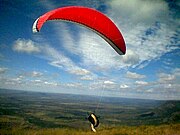



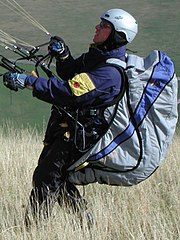
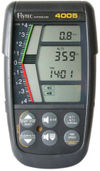



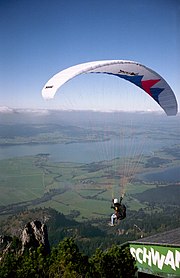

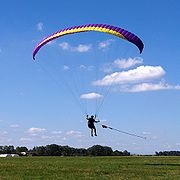


No comments:
Post a Comment